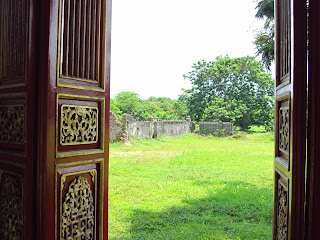 |
| Main Entrance into the Imperial City |
Our resort provided a free shuttle bus to the citadel, but it left at 10am and by the time it reached Hue around noon, the sun was blazing. So, sunglasses, hat and scarf were in order. And sunblock too, on the face and arms. I could see why the locals wore long sleeved, loose clothing - the traditional aodai perfectly suits the climate!
There are many perfectly good sites describing the Imperial City, such as this, and this virtual walking tour of
the Citadel. So I will not reproduce my route but instead go into the details which held more interest for me. Sadly, in any case, much of the Imperial City was bombed during the Vietnam War and was destroyed, in particular most of the Forbidden Purple City. Whilst restoration (or maybe re-creation) work is being done, there is still much to go.
From what I understand from Vietnamese history, the Nguyen Emperors were the last to rule Vietnam. After WWII, the line of the Emperors stopped as Vietnam became torn in two between Ho Chi Minh and the communists in the north and the republicans in the South. Eventually, of course, the communists won the day. One would have supposed that they would have totally repudiated the legacy of the monarchy. And they did, except for one detail.
For whatever else they did, the Vietnamese Emperors had sent their ships out into the surrounding waters, out into the South China Sea where they laid claim to the islands in the area - such as the Spratlys and the Paracels. In other words the two hottest properties in South East Asia today!
These activities were recorded, on the maps of the time and on the nine dynastic urns that one of the Nguyen Emperors commissioned. The urns stand outside the Hian Lam Pavilion, across from the The To Mieu Temple - where most of the Emperors of the Nguyen dynasty are commemorated. The urns depict, amongst other things, scenes of the countryside and of the sea, of flowers and birds and beasts (including one peacock).
The accompanying commentary and description of the urns in the Hian Lam pavillion points out that they also record the "East Sea" (I could not find this though - but searching for individual decorations on nine gigantic urns in the hot sun is not easy, it is not unexpected that we miss things), presumably east of Vietnam, which would be the South China Sea. So this is "evidence", at least from Vietnam's perspective, of the country's historic claims to the Spratlys and Paracels.
There are many perfectly good sites describing the Imperial City, such as this, and this virtual walking tour of
 |
| Ruins of the Purple Forbidden City, from a newly restored corridor |
From what I understand from Vietnamese history, the Nguyen Emperors were the last to rule Vietnam. After WWII, the line of the Emperors stopped as Vietnam became torn in two between Ho Chi Minh and the communists in the north and the republicans in the South. Eventually, of course, the communists won the day. One would have supposed that they would have totally repudiated the legacy of the monarchy. And they did, except for one detail.
 |
| The To Temple with Dynastic Urn |
 |
| Peacock on Dynastic Urn |
These activities were recorded, on the maps of the time and on the nine dynastic urns that one of the Nguyen Emperors commissioned. The urns stand outside the Hian Lam Pavilion, across from the The To Mieu Temple - where most of the Emperors of the Nguyen dynasty are commemorated. The urns depict, amongst other things, scenes of the countryside and of the sea, of flowers and birds and beasts (including one peacock).
The accompanying commentary and description of the urns in the Hian Lam pavillion points out that they also record the "East Sea" (I could not find this though - but searching for individual decorations on nine gigantic urns in the hot sun is not easy, it is not unexpected that we miss things), presumably east of Vietnam, which would be the South China Sea. So this is "evidence", at least from Vietnam's perspective, of the country's historic claims to the Spratlys and Paracels.
 |
| Map Detail |
The competing claims of the various parties contending for ownership of the Spratlys and Paracels will take much time to go into. Other countries will have their own evidence. I am no expert, and putting this up on my blog does not indicate I am taking sides one way or another; it is purely to indicate the interesting point that the present day communist leaders of Vietnam are using the records of the Imperial administration to support their claims.
 |
| Detail - Thai Binh Pavilion |
After our visit, we took a cyclo to the French Boulangerie, a small little cafe which we located in (I believe) Lonely Planet. This little cafe is a social enterprise, set up to train disadvantaged youth to be bakers. The food itself was simple - we had a "Baguette Brest" which is essentially bread topped with cheese, ham, onions, tomato paste etc. There was also a very welcome ice cream for dessert. Not quite an "Imperial" meal, but warm and tasty nonetheless.
This is my fourth visit to Vietnam and I find that the more I visit, the more I find of interest. In Hanoi we explored the ancient capital and the beautiful Ha Long Bay. In Central Vietnam, the old town of Hoi An and the Imperial Capital at Hue. In Ho Chi Minh City, I learnt more about the Vietnam war and visited the Mekong Delta. And still so much more to see.....
More Hue photos found here.
More Hue photos found here.

No comments:
Post a Comment